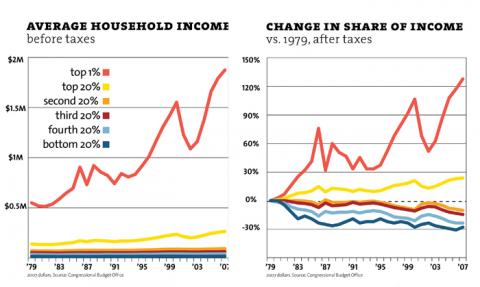We're in denial about our dysfunctional society

The large and ever-growing gap between the richest and the rest is not talked about enough here in Ireland. It should be. By Vincent Browne.
If any readers stayed up last night to watch the post-New Hampshire primary candidate prayer meetings, they probably will have been struck by the banality of the rhetoric and the disconnect between the Republican candidates and the state of America.
That is, if there was a repetition of the post-Iowa caucus shenanigans. No reference to the perilous mountain of state debt, hardly a mention of the 20 million unemployed, no acknowledgment of the drift towards yet another war, this time with Iran, and the prospect of a later conflict with China, as Nobel peace-prize winner Barack Obama seems to envisage.
But perhaps most startling of all, no acknowledgement of how American society has changed over the last 30 years and how deeply divided, socially, America now is. An issue that features not at all in any of the political campaigns there is the huge disparity of wealth and income that has grown in the US.
This is a little surprising as most of the Republican candidates are members of Congress and Congress published last October, via the Congressional Budget Office, a report revealing in stark terms the scale of the transformation: Trends in the Distribution of Household Income Between 1979 and 2007.
It reports that the 1979 to 2007 average household income in the US grew by 62% but for the 1% of the population with the highest income. Their after-tax household income grew by 275% in the same period. The bottom one-fifth of earners had just an 18% increase over the 28 years.
The report states: “The distribution of after-tax household income in the US was substantially more unequal in 2007 than in 1979. The share of income accruing to higher income households increased, whereas the share accruing to other households declined.”
A report by the US Census Bureau in 2010 showed there were 46.2 million people living in poverty in 2010, up from 43.6 million in 2009. For black people, the poverty rate increased to 27.4% in 2010, up from 25.8% in 2009. From 2009 to 2010 the incidence of poverty among children under 18 rose to 22% from 20.7%, while children under the age of 18 in poverty increased to 16.4 million from 15.5 million.
On reflection, however, why should we be surprised there is no talk in America about such huge disparities of income and wealth, since there is no talk here about the enormous disparities in wealth and income here? Or at least no talk by representatives of the main establishment parties, Fine Gael, Labour and Fianna Fáil, nor by the media. It is not so much that people don’t care, but that it’s not on the official agenda and, for the most part, the media sticks to the official agenda and to spin, to which it considers itself immune.
Just a few facts that hardly get mentioned at all now:
- The average income in the highest one-fifth of income earners was 5½ times that of the lowest one-fifth and this gap widened from 4.3 the previous year – Survey on Income and Living Conditions for 2010;
- The same survey found that the scale of inequality of incomes in 2010 was higher (33.9) than at any time from 2004;
- The review found that the “at risk of poverty” rate (60% of median income) was at 15.8% compared with 14.1% the previous year even though the threshold fell by more than 10% from €12,064 in 2009 to €10,831 in 2010;
- According to the OECD, this State was the 23rd most unequal country of 31 OECD countries in the late-2000s;
- The Rich List compiled by the Sunday Times in its 2011 edition noted that the top 20 richest Irish people/families had aggregate wealth of €17.3 billion;
- A survey published in 2001 by the Institute of Public Health in Ireland showed: “In both the North and the South the all-causes mortality rate in the lowest occupational class is 100-200% higher than the rate in the highest occupational class.” This was evident of almost all the main causes of death: for circulatory diseases it was 120% higher; for cancers it was more than 100% higher; for respiratory diseases it was more than 200% higher; for injuries and poisonings it was over 150% higher;
The CSO published in December 2010 corroborating and contemporary data. It showed: “Life expectancy at birth for males in the most deprived areas of the State was 73.7 years in 2006/07, compared with 78 years of those living in the most affluent areas. The corresponding figures for females were 80 and 82.7.”
So it is not just the US that is dysfunctional. We too are in denial about dysfunctions in our own society. And while we send billions to financial elites across Europe and, correspondingly, pare elementary services for ordinary people here to the bone, we claim this is “responsible” and for the “public good”.
But, for now at least, we are spared the prayer meetings, for which, thank God. {jathumbnailoff}
Image top: Mother Jones.
